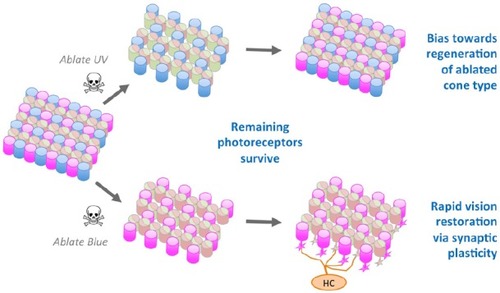Figure 2
- ID
- ZDB-FIG-190723-2383
- Publication
- DuVal et al., 2017 - Impacts of the retinal environment and photoreceptor type on functional regeneration
- Other Figures
- All Figure Page
- Back to All Figure Page
|
Effects of photoreceptor identity on retinal regeneration and functional vision restoration. Both cellular regeneration and the kinetics of synaptic plasticity are differentially affected by the identity of the photoreceptor that is lost. Loss of ultraviolet (UV) cones in zebrafish via pharmacogenetic ablation biases the retina to regenerate UV cones, resulting in restoration of their position and abundance. Alternatively when blue cones are ablated, a robust and rapid restoration of visual function occurs through synaptic plasticity. Meanwhile, the remaining photoreceptor types survive, likely through many pro-survival mechanisms. Thus multiple mechanisms act in response to cone loss, and the identity of the cone type lost (or perhaps the type[s] that remain) affects the mechanisms employed for regeneration and restoration of function. Based on these inferences, the need to consider photoreceptor types during regeneration strategies is apparent: regeneration, survival, and re-wiring of cones into the cone-rich human macula obliges use of appropriately cone-dominant model systems. HC: Horizontal cell. |

